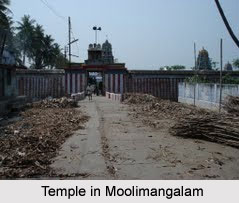 Moolimangalam is situated in Karur district in the Indian state of Tamil Nadu.
Moolimangalam is situated in Karur district in the Indian state of Tamil Nadu.
Location of Moolimangalam
Moolimangalam is a small urban area resided by almost 1000 people. The town has almost 250 homes and is positioned in the 3rd and 4th wards of Tamil Nadu Kagitha Alai Town Panchayat. Karur is almost 11 km northwest of Moolimangalam. The town is surrounded by few villages like Kurukkapalayam, Pandipalayam, Pazhamapuram, Sottaiyur, Masagoundanpudur, Sokkankadu, Ponniagoundanpudu and Thadampalayam. Moolimangalam has an average elevation of 125 meters (413 feet).
Education of Moolimangalam
Moolimangalam has established several schools and colleges to cater to the educational needs to the children residing in the town. A primary Panchayat school imparting education in Tamil is attended by many students. Other than this there are several other schools here like the Pugalur Public School, TNPL Matriculation and Higher secondary school, Pugalur Boys and Girls High School. The literacy rate of Moolimangalam is almost 30-40% that is lower than the national average rate of 59.5%. One of the major engineering colleges M. Kumarasamy College of Engineering (MKCE) is located nearby to the town. It is prominent landmark on the National Highway No.7 and falls on the Karur - Salem route. It is almost at a distance of 5 kilometres from Moolimangalam. M. Kumarasamy College of Engineering is affiliated to the Anna University in Chennai. The All India Council of Technical Education, New Delhi has also approved the college. The college earns the reputation of producing several engineering graduates, physicians and lawyers.
Economy of Moolimangalam
The main source of income for the inhabitants of Moolimangalam is agriculture. There are few people who work in TNPL Company. The TEWLIS project had helped in boosting the agro business of the town. The TEWLIS project has helped the village pipelines receive effluent water that are pumped from TNPL. The Thirukkattuthurai village panchayat situated on the banks of Kaveri River provide water to TNPL. The TNPL Panchayat look after the maintenance of the water taps and the 2 wells constructed for public use. Some of the important crops grown here are paddy and sugarcane. Coconut trees are also grown on a large scale in Moolimangalam. The textile industry located at Karur also provides employment to the residents of the town. The town also has one public library.
Culture of Moolimangalam
Moolimangalam is a significant pilgrimage centre visited by many devotees from different places. The Pillaiyar temple constructed in the year 2009 is an important shine here. Other than this there are other temples here like Sellandiamman Temple and Maruthaiveeran Temple. Another temple has been built for the Naidus. Several festivals are celebrated in the town with much zeal and fervour. Sellandiamman festival is the most famous festival celebrated on a grand scale. The town is beautifully decorated during the festive season. Sellandiamman festival is organised in the Tamil month of `Panguni`. Villagers from nearby village visit the town with their family and relatives. The festival is celebrated for 2 days. The youths stage drama during the festival that is the most admired entertainment show of the TNPL panchayat. The crowds gather to see the drama. Apart from this, the Mariamman festival is another important festival celebrated in Moolimangalam. The Mariamman temple is situated in Nanaparappu almost 4 kilometres away from Moolimangalam. The inhabitants of the town also celebrate festivals like Pongal and Diwali.
Visiting Information to Moolimangalam
Moolimangalam is well connected with all modes of transport. Several Private Mini Bus and Government run buses are available for the town. The inhabitants of the town commute by two wheeler motorcycles as well as bi-cycles to travel from one place to another. The nearest railway station is located in the close by town Pugalur. The railway station is well connected to all the important towns and cities like Coimbatore, Erode, Chennai, Trichy, and Kochi. Both express trains and passenger trains go through this station. The nearest airport is located in Trichy that is located at a distance of almost 87 km. other than these maximum number of airports are located at Coimbatore.



















